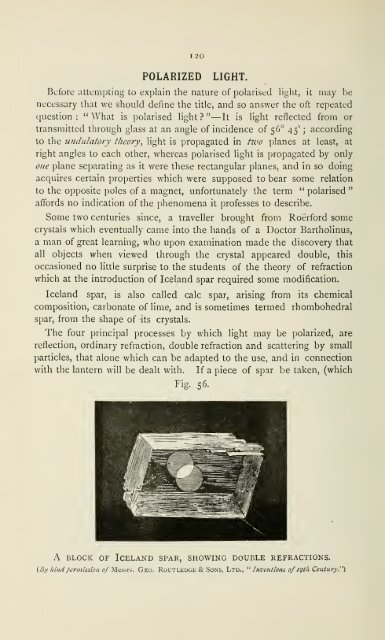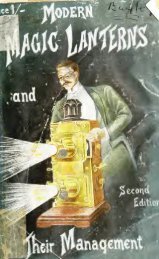- Page 1 and 2:
THEPROJECTIO,MA GIC LANTERN MANUAL
- Page 3:
OCSBLIBRAPY
- Page 7:
..INDEXA.Adjustment of a JclAlumini
- Page 10 and 11:
—increased by the aid of a powerf
- Page 12 and 13:
far back as 1811. Lanterns of the a
- Page 14 and 15:
mixadvisable to have a mahogany, or
- Page 16 and 17:
8A condenser can only take those ra
- Page 18 and 19:
There is a considerable difference
- Page 20 and 21:
12occasions, it is only necessary t
- Page 22 and 23:
14Triplexicon was first made it was
- Page 24 and 25:
i6aid of two screws. The two slots
- Page 26 and 27:
perfection, combustion, and purity,
- Page 30 and 31:
20back of lantern, in that case the
- Page 32 and 33:
sumed, the flow should be adjusted
- Page 34 and 35:
24which is passed over the rod, and
- Page 36 and 37:
26gases to be shut off without dist
- Page 38 and 39:
28made in their get up. We have nev
- Page 41 and 42:
3tserve to distribute the same to t
- Page 43 and 44:
(V>ao—IH
- Page 45 and 46:
;33the thing a study, and used such
- Page 47 and 48:
V>-is:a
- Page 49 and 50:
35who designed the body of this lan
- Page 51 and 52:
37far back but equally flat to the
- Page 53 and 54:
39ceding one, therefore giving grea
- Page 55 and 56:
4tthe same as they do, in fact it i
- Page 57 and 58:
—43reducing same as low as possib
- Page 59 and 60:
45With all three discs, as coincide
- Page 61 and 62:
47and the slides may be placed in a
- Page 63 and 64:
49inch and inch and-a-half screws,
- Page 65 and 66:
SIshowing, gently push back the cov
- Page 67 and 68:
53sun rising and illuminating the p
- Page 69 and 70:
55large slides it was necessary to
- Page 71 and 72:
57A. Is a right angle prism, being
- Page 73 and 74:
59small diameter as through an obje
- Page 75 and 76:
—6isize of disc can be produced.
- Page 77 and 78:
—63COMPRESSED GASES.Compressed ga
- Page 79 and 80:
6sNO DANGER WITH GAS CYLINDERS,OR B
- Page 81 and 82:
"67valves are of little use as a me
- Page 83 and 84: 69to reach our compressors without
- Page 85 and 86: ——71ascertain their bursting po
- Page 87 and 88: —73bottles black, and hydrogen (o
- Page 89 and 90: ;Having blown through every tube to
- Page 91 and 92: 77controlling the flow of compresse
- Page 93 and 94: 79The Duplex.—The chieffeaturecon
- Page 95 and 96: —8icarries the gas to the orifice
- Page 97 and 98: 83the above-mentioned tube, whilst
- Page 99 and 100: 8sTable for Ascertaining the Quanti
- Page 101 and 102: 87On no account use two separate bo
- Page 103 and 104: 89virtue, and if required to be use
- Page 105 and 106: 91In finishing up, turn out the hgh
- Page 107 and 108: 93good support in one sense— but
- Page 109 and 110: 95another takes its place without a
- Page 111 and 112: 97opposite side to that which he is
- Page 113 and 114: 99without doubt, this is the only t
- Page 115 and 116: lOIFig 56.SCREEN FRAMES.Considerabl
- Page 117 and 118: I03and hauled up. The pulley blocks
- Page 119 and 120: PRACTICAL HINTS TO INTENDING LECTUR
- Page 121 and 122: 107as well as the lecturer, a syste
- Page 123 and 124: 109Fig. 57- Fig. 58.READING LAMP.A
- Page 125 and 126: oils have to be substituted simply
- Page 127 and 128: 1^3Fig. 54.A cheap but none the les
- Page 129 and 130: 115Directions.— Having thoroughly
- Page 131 and 132: 117objectives which will not give s
- Page 133: 119is immersed, then as the water e
- Page 137 and 138: 123particular kind of structure und
- Page 139 and 140: 125the complementary colour to red
- Page 141 and 142: 127of a combined microscope and pol
- Page 143 and 144: 129without this defect is well nigh
- Page 145 and 146: 131diameter, and focus, the general
- Page 147 and 148: 133The loss of light is not so grea
- Page 149 and 150: 135cheap as circular pattern, but t
- Page 151 and 152: ^37A variety of subjects may be tre
- Page 153 and 154: —139on an average far superior re
- Page 155 and 156: —141development, immerse in the f
- Page 157 and 158: 143Hydrokinone.Solution I. Solution
- Page 159 and 160: —145Add r drop of solution of Bro
- Page 161 and 162: 147crystal varnish, some red sable
- Page 163 and 164: 149boiled oil to the medium. Perfec
- Page 165 and 166: ;151sienna to impart warmth without
- Page 167 and 168: iS3front glass injuring the paintin
- Page 169 and 170: 155Fig 73-Fig 74.handle to which th
- Page 171 and 172: ;157follows :—one end of the fram
- Page 173 and 174: 159on any slide providing it is dar
- Page 175 and 176: i6iTrough, which consists of two gl
- Page 177 and 178: —i63It is advisable to fill the t
- Page 179 and 180: i65matter on the surface of the pur
- Page 181 and 182: —167planation we have indicated i
- Page 183 and 184: 169single light box is very mislead
- Page 185 and 186:
ADVERTISEMENTS.
- Page 187 and 188:
ADVERTISEMENTS. 173HAZELL, WATSON,
- Page 189 and 190:
ADVERTISEMENTS.I75Brilliant Effect.
- Page 191 and 192:
;ADVERTISEMENTS.ILIFFE & SOIL'SP HO
- Page 193 and 194:
ADVERTISEMENTS. 179ENORMOUS SUCCESS
- Page 195 and 196:
ADVERTISEMENTS.HUGHES' NEW PATTERN
- Page 197 and 198:
ADVERTISEMENTS. 183RussianJronJLamp
- Page 199 and 200:
TheADVERTISEMENTS. 185THE GRIND BIU
- Page 201 and 202:
nothingADVF.RTISE^[E^TS.iS7HUGHES'H
- Page 203 and 204:
THE MINIATURE MALDEN TRIPLE.HUGHES'
- Page 205 and 206:
No. 1 Lantern.THE: UNIVERSALMAGICLA
- Page 207 and 208:
!ADVERTISEM ENTS.Hughes' Special Pa
- Page 209 and 210:
:ADVERTISEMENTS. 191To Lecturers an
- Page 211 and 212:
ADVERT iSF.MENTS.1^3I^ ANTERNNEGATI
- Page 213:
ENGLANDSLANTERNAREPLATESUNSURPASSED
- Page 217:
A 000 618 714





